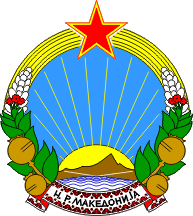63 years with Socialist Emblem
 These days it was the 63 birthday of the Amblem of the People’s Republic of Macedonia.
These days it was the 63 birthday of the Amblem of the People’s Republic of Macedonia.
His form, unlike most socialist countries and republics, the historical Arms did not find a place in the new socialist emblem, created after the “Arms” of the USSR. Instead of historical and Arms, the emblem of N.R. Macedonia takes pure landscape composition, and thus fell into the same category as Romania, Bosnia and Herzegovina and Montenegro. The authorship is attributed back to Vasilie Popovic – Cico, who probably is the author of the artistic interpretation of emblazon included on the Arms on the bill, which was used until the end of that year. He knew of the Land Arms of Macedonia. There is an opinion that the author of today’s back is George Andrejevic – Kun, to whom it is attributed the authorship of Arms of the other republics of FNRY thus unifying the style .
Coat of P.R. Macedonia was adopted on second special session of the People’s Assembly held in Skopje on 26 July 1946, where the law enacted the Coat of Arms of the P.R. Macedonia, and Article 1 of this law gives the description (blazon) of this Arms:
Arms of the People’s Republic of Macedonia is a field surrounded by stalks of wheat mixed with poppy fruit and tobacco leaf, on the lower side is connected with a ribbon painted with folk motifs. On the ribbon is written “P. R. Macedonia”. Among the peaks of stalks is a five pointed star. In the middle of the field a mountain is outlined, at which bottom a river flows. Behind the mountain is a rising sun.
The newspaper “Nova Makedonija”, two days later, announcing this law with the image and explanation:
Arms of the People’s Republic of Macedonia is a symbol of freedom and brotherhood of the Macedonian people and the richness of the Macedonian country. The stalks of wheat, opium poppies and tobacco leaves are representing the riches of Macedonia and the diversity of its economy. Star symbolizes the liberation war by which the Macedonian nation won its freedom. Folklore motif of the ribbon expresses the richness and beauty of the national essence. In the middle is the Pirin Mountain, the largest Macedonian mountain, which was the center of liberation wars in past, and the river flowing is river Vardar, the most famous river in the country. Pirin and Vardar simultaneously represent the unity of all parts of Macedonia and the ideal of our people for national reunification. The sun represents the free and creative life in Macedonia.
It is interesting to note that the design and the explanation of the Arms is different from the Arms used later. The first Constitution of the People ‘s Republic of Macedonia, in Article 3 is defined Coat of Arms:
Coat of Arms of the People’s Republic of Macedonia is a field surrounded by stalks of wheat mixed with fruits of the poppy and tobacco leaves, which are connected to the bottom with a ribbon with folk motifs. Among the peaks of stalks a five pointed star. Amid the mountain area is outlined at the foot of which a river flows. Behind the mountain sun rises .
This description, as the previous one, does not mention a single color. The only difference is that the Constitution ribbon does not bear text. The seal that certified this document is the Coat of Arms design first published in “Nova Makedonija”, while the impression in wax of the seal, is the new design of the Arms.
In Article 4 of the Constitution states:
State flag of the People’s Republic of Macedonia is red with a five pointed star. The star is red with gold / yellow / edge and has a proper five pointed shape. The ratio of width and length of the flag is one to two.
With the dissolution of SFR Yugoslavia, the question of the Coat of Arms arose. Thus, the government established a committee to establish the Arms and flag of the Republic of Macedonia in 1992 consisted of: Aneta Svetieva-ethnologist, Alexander Cvetkovski-artist, Costa Balaban art historian, Dimitar Kondovski-artist. The panel included Matkovski. On the competition arriving more than 3,000 works, most of which is inspired by the book published by the Institute of National History, which is re-published in 1990. Unfortunately, Matkovski dies not long before the Law discussion, but leaves his message which was read in the Parliament, in which Matkovski expresses his view that as the Coat of Arms should be accepted the historical Arms. Commission fails to agree on a proposal that would present to the Assembly. The issue became highly politicized.
Due to the lack of a majority, this law never entered the parliamentary debate, and although by constitutional law, this law had to be adopted by the end of 1992. Macedonian passports are issued without an Arms, so that it can be further impressed as soon as it is enacted. This lasted until 2006, when new passports were issued bearing the old coat of arms of the People’s Republic of Macedonia.
In addition, Macedonia has no presidential flag put back into a category that has very few countries.



